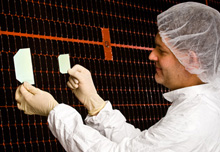
| Home | About Us | Contribute | Bookstore | Advertising | Subscribe for Free NOW! |
| News Archive | Features | Events | Recruitment | Directory |
News
2 November 2010
Spectrolab produces 3 millionth multi-junction space solar cell
Boeing Company subsidiary Spectrolab Inc of Sylmar, CA, USA has produced its 3 millionth multi-junction, space-based solar cell. Production records indicate that the gallium arsenide cell was delivered during the week of 25 October. Spectrolab has been manufacturing multi-junction solar cells for more than 15 years and other space products for more than 50 years.
“Our customers expect flawless satellites that can endure many years in space to enable national-security and Earth-observation missions, as well as consumer and business communications,” says Craig Cooning, VP & general manager, Boeing Space & Intelligence Systems. “Spectrolab’s solar cells have powered more than 500 satellites and interplanetary missions,” he adds.
Spectrolab has been developing high-efficiency solar cells for space missions since the firm's founding in 1956. During the Apollo 11 mission in 1969, a Spectrolab product became the first solar panel to be placed on the moon. Today, Spectrolab solar panels are the only panels in operation on Mars, as part of a reconnaissance satellite and two land-exploration rovers.
 Spectrolab recently delivered solar panels to the NASA-Jet Propulsion Laboratory JUNO mission (the first mission to Jupiter to be powered by photovoltaic cells). Spectrolab’s currently cells and panels power about 60% of all satellites in Earth's orbit, as well as the International Space Station.
Spectrolab recently delivered solar panels to the NASA-Jet Propulsion Laboratory JUNO mission (the first mission to Jupiter to be powered by photovoltaic cells). Spectrolab’s currently cells and panels power about 60% of all satellites in Earth's orbit, as well as the International Space Station.
“Many years of continuous improvement in product design and high-volume manufacturing experience have allowed Spectrolab to develop mature, cost-effective and repeatable processes, resulting in the delivery of high-quality, reliable and affordable products to both space and terrestrial customers,” says Spectrolab’s president David Lillington. “Our business continues to grow as we gain market share. We are increasing productivity and introducing higher levels of automation to meet this increased demand,” he adds. “We expect to announce the production start of our next-generation space cells early next year.”
In 2001, Spectrolab embarked on a strategy to adapt its space solar cell technology for terrestrial applications, converting concentrated sunlight to electricity with an average efficiency of more than 38.5% and benefiting from the same equipment, materials and processes used for space manufacturing. In 2009, a Spectrolab triple-junction, lattice-matched cell set a record of 41.6% for terrestrial concentrator solar conversion efficiency. This year, Spectrolab will deliver about 50MW of solar cells to terrestrial concentrated photovoltaic (CPV) customers, and expects to produce almost 150MW in 2011.
![]() Search: Spectrolab Triple-junction cells GaAs solar cell
Search: Spectrolab Triple-junction cells GaAs solar cell
Visit: www.spectrolab.com
For more: Latest issue of Semiconductor Today